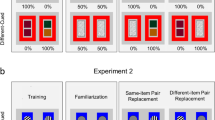Abstract
Almost all nonhuman animals can recognize when one item is the same as another item. It is less clear whether nonhuman animals possess abstract concepts of “same” and “different” that can be divorced from perceptual similarity. Pigeons and monkeys show inconsistent performance, and often surprising difficulty, in laboratory tests of same/different learning that involve only two items. Previous results from tests using multi-item arrays suggest that nonhumans compute sameness along a continuous scale of perceptual variability, which would explain the difficulty of making two-item same/different judgments. Here, we provide evidence that rhesus monkeys can learn a two-item same/different discrimination similar to those on which monkeys and pigeons have previously failed. Monkeys’ performance transferred to novel stimuli and was not affected by perceptual variations in stimulus size, rotation, view, or luminance. Success without the use of multi-item arrays, and the lack of effect of perceptual variability, suggests a computation of sameness that is more categorical, and perhaps more abstract, than previously thought.



Similar content being viewed by others
References
Benton MJ, Donoghue PCJ, Asher RJ (2009) Calibrating and constraining molecular clocks. In: Hedges SB, Kumar S (eds) The timetree of life. Oxford Univ Press, Oxford, pp 35–86
Blaisdell AP, Cook RG (2005) Two-item same-different concept learning in pigeons. Anim Learn Behav 33(1):67–77. doi:10.3758/BF03196051
Brown MF, Sayde JM (2013) Same/different discrimination by bumblebee colonies. Anim Cognit 16(1):117–125. doi:10.1007/s10071-012-0557-z
Castro L, Kennedy PL, Wasserman EA (2010) Conditional same-different discrimination by pigeons: acquisition and generalization to novel and few-item displays. J Exp Psychol Anim Behav Process 36(1):23–38. doi:10.1037/a0016326
Flemming TM, Beran MJ, Washburn DA (2007) Disconnect in concept learning by rhesus monkeys (Macaca mulatta): judgment of relations and relations-between-relations. J Exp Psych Anim Behav Process 33(1):55–63. doi:10.1037/0097-7403.33.1.55
Flemming TM, Thompson RKR, Fagot J (2013) Baboons, like humans, solve analogy by categorical abstraction of relations. Anim Cognit 16(3):519–524. doi:10.1007/s10071-013-0596-0
Fujita K (2004) How do nonhuman animals perceptually integrate figural fragments? Jpn Psychol Res 46(3):154–169. doi:10.1111/j.1468-5584.2004.00248.x
Gellermann LW (1933) Chance orders of alternating stimuli in visual discrimination experiments. Pedagog Semin J Genet Psychol 42(1):206–208. doi:10.1080/08856559.1933.10534237
Giurfa M, Zhang S, Jenett A, Menzel R, Srinivasan MV (2001) The concepts of ‘sameness’ and ‘difference’ in an insect. Nature 410(6831):930–933. doi:10.1038/35073582
Howell DC (1997) Statistical methods for psychology, 4th edn. Duxbury Press, Belmont
Izquierdo A, Murray EA (2007) Selective bilateral amygdala lesions in rhesus monkeys fail to disrupt object reversal learning. J Neurosci 27(5):1054–1062. doi:10.1523/jneurosci.3616-06.2007
Jarvis ED, Güntürkün O, Bruce L et al (2005) Avian brains and a new understanding of vertebrate brain evolution. Nat Rev Neurosci 6(2):151–159. doi:10.1038/nrn1606
Katz JS, Wright AA, Bachevalier J (2002) Mechanisms of same/different abstract-concept learning by rhesus monkeys (Macaca mulatta). J Exp Psych Anim Behav Process 28(4):358–368
Katz JS, Wright AA, Bodily KD (2007) Issues in the comparative cognition of abstract-concept learning. Comp Cognit Behav Rev 2:79–92
Mishkin M, Delacour J (1975) Analysis of short-term visual memory in monkeys. J Exp Psych Anim Behav Process 1(4):326–334. doi:10.1037/0097-7403.1.4.326
Nemanic S, Alvarado MC, Bachevalier J (2004) The hippocampal/parahippocampal regions and recognition memory: insights from visual paired comparison versus object-delayed nonmatching in monkeys. J Neurosci 24(8):2013–2026
Penn DC, Holyoak KJ, Povinelli DJ (2008) Darwin’s mistake: explaining the discontinuity between human and nonhuman minds. Behav Brain Sci 31(02):109–130
Qadri MAJ, Cook RG (2015) Experimental divergences in the visual cognition of birds and mammals. Comp Cogn Behav Rev 10:73–105. doi:10.3819/ccbr.2015.100004
Quine WV (1969) Natural kinds. In: Rescher N (ed) Essays in honor of Carl G. Hempel: a tribute on the occasion of his sixty-fifth birthday. D. Reidel, Dordrecht, pp 5–23
Rudebeck PH, Murray EA (2008) Amygdala and orbitofrontal cortex lesions differentially influence choices during object reversal learning. J Neurosci 28(33):8338–8343
Shimizu T, Watanabe S (2012) The avian visual system. In: Lazareva OF, Shimizu T, Wasserman E (eds) How animals see the world: comparative behavior, biology, and evolution of vision. Oxford University Press, New York, pp 473–482
Soto FA, Wasserman EA (2012) Visual object categorization in birds and primates: integrating behavioral, neurobiological, and computational evidence within a “general process” framework. Cog Affect Behav Neurosci 12(1):220–240. doi:10.3758/s13415-011-0070-x
van den Berg R, Vogel M, Josić K, Ma WJ (2012) Optimal inference of sameness. Proc Nat Acad Sci 109(8):3178–3183. doi:10.1073/pnas.1108790109
Wasserman EA, Young ME (2010) Same–different discrimination: the keel and backbone of thought and reasoning. J Exp Psychol Anim Behav Process 36(1):3–22. doi:10.1037/a0016327
Wasserman EA, Young ME, Fagot J (2001) Effects of number of items on the baboon’s discrimination of same from different visual displays. Anim Cognit 4(3–4):163–170. doi:10.1007/s100710100095
Wright AA, Katz JS (2007) Generalization hypothesis of abstract-concept learning: learning strategies and related issues in Macaca mulatta, Cebus apella, and Columba livia. J Comp Psych 121(4):387–397
Young ME, Wasserman EA (1997) Entropy detection by pigeons: response to mixed visual displays after same–different discrimination training. J Exp Psychol Anim Behav Process 23(2):157–170. doi:10.1037/0097-7403.23.2.157
Young ME, Wasserman EA (2001) Evidence for a conceptual account of same-different discrimination learning in the pigeon. Psychon Bull Rev 8(4):677–684. doi:10.3758/BF03196203
Young ME, Wasserman EA, Garner KL (1997) Effects of number of items on the pigeon’s discrimination of same from different visual displays. J Exp Psych Anim Behav Process 23(4):491–501. doi:10.1037/0097-7403.23.4.491
Young ME, Ellefson MR, Wasserman EA (2003) Toward a theory of variability discrimination: finding differences. Behav Process 62(1–3):145–155
Young ME, Wasserman EA, Ellefson MR (2007) A theory of variability discrimination: finding differences. Psychon Bull Rev 14(5):805–822. doi:10.3758/BF03194106
Acknowledgments
David P. Charles passed away on October 17, 2006. We thank Luke Humphrey for help testing monkeys. We thank an anonymous reviewer for suggesting an additional analysis. This work was supported by the Intramural Research Program of the National Institute of Mental Health. The authors declare that they have no conflict of interest. All procedures were reviewed and approved by the NIMH Animal Care and Use Committee and complied with US law.
Author information
Authors and Affiliations
Corresponding author
Rights and permissions
About this article
Cite this article
Basile, B.M., Moylan, E.J., Charles, D.P. et al. Two-item same/different discrimination in rhesus monkeys (Macaca mulatta). Anim Cogn 18, 1221–1230 (2015). https://doi.org/10.1007/s10071-015-0891-z
Received:
Revised:
Accepted:
Published:
Issue Date:
DOI: https://doi.org/10.1007/s10071-015-0891-z




